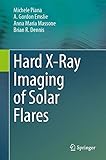Hard X-Ray Imaging of Solar Flares [electronic resource] /
Material type: TextPublisher: Cham : Springer International Publishing : Imprint: Springer, 2022Edition: 1st ed. 2022Description: XVIII, 164 p. 53 illus., 33 illus. in color. online resourceContent type:
TextPublisher: Cham : Springer International Publishing : Imprint: Springer, 2022Edition: 1st ed. 2022Description: XVIII, 164 p. 53 illus., 33 illus. in color. online resourceContent type: - text
- computer
- online resource
- 9783030872779
- 006.37 23
- TA1634
1. Hard X-ray Emission in Solar Flares -- 2. X-Ray Imaging Methods -- 3. RHESSI and STIX -- 4. Image Reconstruction Methods -- 5. Count-based Imaging Methods -- 6. Visibility-based Imaging Methods -- 7. Application to Solar Flares -- 8. Future Possibilities.
The idea for this text emerged over several years as the authors participated in research projects related to analysis of data from NASA's RHESSI Small Explorer mission. The data produced over the operational lifetime of this mission inspired many investigations related to a specific science question: the when, where, and how of electron acceleration during solar flares in the stressed magnetic environment of the active Sun. A vital key to unlocking this science problem is the ability to produce high-quality images of hard X-rays produced by bremsstrahlung radiation from electrons accelerated during a solar flare. The only practical way to do this within the technological and budgetary limitations of the RHESSI era was to opt for indirect modalities in which imaging information is encoded as a set of two-dimensional spatial Fourier components. Radio astronomers had employed Fourier imaging for many years. However, differently than for radio astronomy, X-ray images produced by RHESSI had to be constructed from a very limited number of sparsely distributed and very noisy Fourier components. Further, Fourier imaging is hardly intuitive, and extensive validation of the methods was necessary to ensure that they produced images with sufficient accuracy and fidelity for scientific applications. This book summarizes the results of this development of imaging techniques specifically designed for this form of data. It covers a set of published works that span over two decades, during which various imaging methods were introduced, validated, and applied to observations. Also considering that a new Fourier-based telescope, STIX, is now entering its nominal phase on-board the ESA Solar Orbiter, it became more and more apparent to the authors that it would be a good idea to put together a compendium of these imaging methods and their applications. Hence the book you are now reading.


There are no comments on this title.